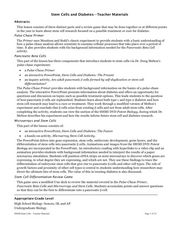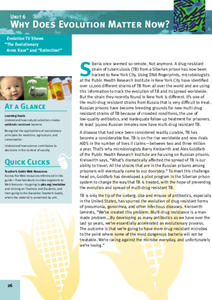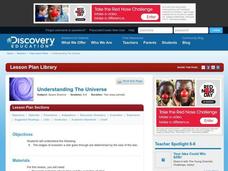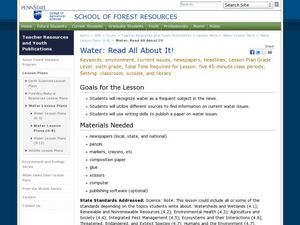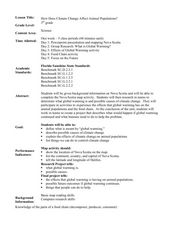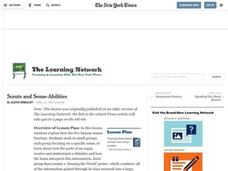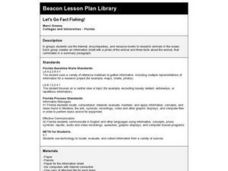Curated OER
4-H Line & Design Activity Page
What a great activity for students. This 4-H activity sheet has students organize their bedroom, and make clothing, focusing on line and design.
Curated OER
Magic School Bus: The Wild Whale Watch Lesson Plan
Students research information about whales. In this early childhood lesson plan, students create an illustration of a whale to display in a sea scene in the classroom. Students then use the library and internet to research a whale of...
Curated OER
Exploring Explorations
Students describe human benefits from ocean exploration. In this ocean exploration lesson plan, students focus on the historical, biological, and physical features of the deep oceans and man's exploration.
Howard Hughes Medical Institute
Stem Cells and Diabetes
Learners investigate stem cells. In this science instructional activity, students discuss stem cells and view a video about human embryonic development. Learners conduct the pulse-chase.
Curated OER
Water: Where in the Watershed?
Students become connected to their watershed by exploring a local water body and mapping its features. They focus on how the local watershed fits into the larger scheme of the watershed.
Curated OER
Why Does Evolution Matter Now?
Students examine how natural selection creates antibiotic-resistant bacteria,
recognize applications of evolutionary principles for medicine, agriculture, and conservation, and discuss how science contributes to decisions in context of...
Curated OER
Bean Sprout
Student will track the growth of his/her bean sprout with sunlight and without sunlight over the course of 3 weeks. They will enter the results into an excel data base then graph the results of both variables to make the comparison.
Curated OER
The Universe
Students recognize that the stages of evolution a star goes through are determined by the size of the star. They conduct research to draw a set of diagrams illustrating the stages in the evolution of three sizes of stars.
Curated OER
Water: Read All About It!
Students discuss newspapers and water and work in groups to develop their own paper focusing on water issues. In this journalism lesson, students discuss the value of newspapers and water as an issue. They work as a group to develop a...
Curated OER
How Does Climate Change Affect Animal Populations?
Students investigate the effect of climate change on animal population in Nova Scotia. In this environmental science lesson, students complete a Nova Scotia map activity and research the causes of global warming in small groups. Students...
Curated OER
Being Productive in the Arctic Ocean
Students identify the three realms of the Arctic Ocean, and describe the relationships between these realms. They identify major factors that limit primary productivity in the Arctic Ocean.
Curated OER
Scents And Sense-Abilities
Students explore how the five human senses function. They work in small groups, each group focusing on a specific sense. Each group then creates a 'Sensing the World' poster which combines all of the information gained through in-class...
Curated OER
Gorillas In The Midst
Students consider the idea of the eco-tour, and examine different aspects of the Mountain Gorilla Project eco-tour in Rwanda. They synthesize their understanding by acting as expert panelists on a morning news show that focuses on the...
Curated OER
Let's Go Fact Fishing!
Students work in pairs to research animals in the ocean. They use the Internet, encyclopedias, and resource books to complete an information sheet with a photo of the animal and three facts. They present their mini-reports to the class.
Curated OER
Viral Hijackers
Students discover how viruses effect living organisms. Focusing on HIV, they explain why it is unique and how it attacks the immune system. They simulate the spread of viruses through an experiment using water containing sodium...
Curated OER
Dinosaurs Here Yesterday Gone Today
Students take a pre-test to show their prior knowledge of dinosaurs. Using the internet, they reasearch the time period in which they roamed the Earth. Focusing on the area of Connecticut, they compare and contrast the large and small...
Curated OER
Light and Our World
In this science worksheet, students solve a variety of curriculum related puzzles. They also practice basic mental math skills using four operations. The concept of light and color are explored and how it interacts with different objects.
Curated OER
How Much Oxygen Is In The Air?
In this science worksheet, students take a close look at the composition of air while focusing on the content of oxygen. They use clay to model the amounts.
Curated OER
Observing Decomposition
In this science worksheet, students focus upon the concept of decomposition and collect data in order to make interpretations or observations.
Curated OER
IUPAC Rules for Naming Compounds with Functional Groups
In this naming compounds with functional groups worksheet, students read about using the IUPAC rules for naming these compounds and they draw structures for 3 -carbon, 2-carbon and 4-carbon molecules and give the names for each.
TryEngineering
Engineering Air Traffic
Students work as air traffic controllers to read the radar and land 3 planes safely. In this engineering lesson, students use what they have learned about the principles and engineering and radar to land 3 planes then evaluate the...
TryEngineering
Irrigation Ideas
Students design and build an irrigation system that can move water from one place to another. In this engineering lesson, students test whether their system can move two cups of water to at least three feet from the source. They evaluate...
Alabama Learning Exchange
Animal Classification
Present information about the classification of animals. After participating in the teacher-led discussion about scientific names, small groups devise their own way of classifying everyday objects present in the classroom, developing...
Curated OER
Cellular Respiration
In this cellular respiration learning exercise, students answer 34 questions in a variety of types including fill in the blank, short answer and matching. All questions focus on specific parts of the respiration process.





